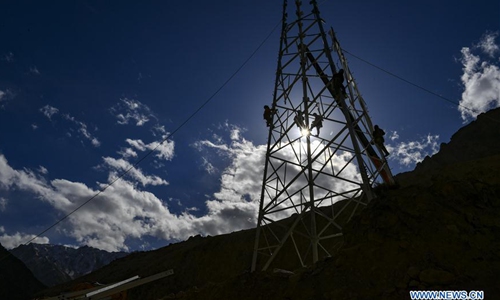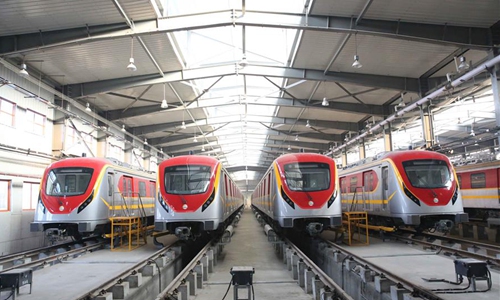China's investment spree soothes virus worries, but caution urged over side effects: analysts
Projects lead the way in resuming work, boosting activity

Technicians work on an electric transmission tower in Maryang township, Tajik Autonomous county of Taxkorgan, Northwest China's Xinjiang Uygur Autonomous Region, Nov 23, 2019. Photo: Xinhua
Local governments in China have announced a series of infrastructure investment projects worth nearly $5 trillion, in a promising indication that China is accelerating efforts to revive economic activities after an extended period of closures due to the coronavirus epidemic and that the Chinese economy will get a much-needed boost.
The large-scale, mostly government-led infrastructure projects, given their close connections to a long list of sectors, could potentially be very effective in leading many businesses and factories to resume operations and production soon, generating new jobs and propelling economic growth, analysts said.
However, officials must also strike a delicate balance between using infrastructure investments to boost economic growth at such a difficult time and avoiding old-fashioned "flood irrigation" stimulus that could lead to waste and other risks, the analysts noted. A focus on sectors with new growth potential such as public health and 5G could be the answer, they said.
Boosting activity
As of Sunday, eight provinces in China including North China's Hebei Province and East China's Fujian Province have reportedly rolled out investment plans worth 33.83 trillion yuan ($4.86 trillion) in total. Majority of the capital would be channeled to transportation, infrastructure and manufacturing.
Some of these projects are already on the way to implementation. Last week, China Three Gorges Corp announced it was kick-starting 25 new-energy projects with an input of 58 billion yuan ($8.27 billion) in total. The construction of a high-speed railway linking Zhengzhou, capital of Central China's Henan Province and Jinan, capital of East China's Shandong Province, also started on February 27, according to media reports.
This news presents promising indications that more projects are resuming construction as the epidemic is increasingly under control. More importantly, the infrastructure projects could also offer a boost to the Chinese economy, which is expected to slow down significantly due to the epidemic, analysts noted.
"Compared with monetary policies, expanding infrastructure investment is an effective way to cope with external shocks like financial crisis and of course, the coronavirus. It can help economy revert back to a normal state," Chen Run, an economist at the Institute of Economic System and Management under the National Development and Reform Commission, told the Global Times.
While growth in China is increasingly driven by consumption, investment still contributes a large proportion to growth. In 2019, consumption accounted for 57.8 percent of GDP growth, while investment contributed 31.2 percent and exports accounted for 11 percent.
"The implementation of this round of infrastructure investments would play a 'huge' role in cushioning an economic tumble triggered by the epidemic. With a targeted investment stimulus, China's economy can still achieve above 6 percent growth this year and continue to be an important driver of global economic growth and an anchor for global markets," Chinese economist Song Qinghui told the Global Times.
Apart from their role in boosting economic growth, infrastructure projects could also prop up growth in a series of industries in upstream and downstream sectors such as machinery and construction materials and generate job growth, analysts and industry insiders said.
"Take the Zhengzhou-Jinan high-speed railway project for example, I assume its construction can create demands for at least scores of industries ranging from excavator, steel to earth work and concrete," Li Hongbao, an excavator industry observer, told the Global Times on Tuesday, however adding that it's hard to predict the exact impacts of the project on those industries.
He also said that the rate of utilization for excavators has climbed to about 30 percent from a low point of 10 percent domestically, as companies across the country gradually resume work. "The government's emphasis on infrastructure projects is undoubtedly a bonus for our industry. We look forward to it," he said.
Tian Yun, vice director of the Beijing Economic Operation Association, also said that the project would benefit a number of upstream industries like engineering design and even catering.
"Some engineering designing companies that I know of have suffered from China's slowing investment growth in recent years. But now they are getting busier as domestic investment gets back on the horse," he told the Global Times, adding that such a project like the Zhengzhou-Jinan railway can create "thousands of jobs."
The benefits of China's infrastructure projects could also be felt by foreign companies. "Such demand allows foreign companies to explore opportunities in the Chinese market with great potential," Yin Naxin, marketing director of ADP Ingénierie China, told the Global Times, adding that the epidemic will not change the company's strategy for China.

Trains of the metro train service are seen at a terminal station in Lahore, Pakistan, on December 10, 2019. Pakistan's first-ever mass rapid urban transit train took its first test run on Tuesday after the completion of the physical infrastructure of the project under the CPEC. Photo: Xinhua
Focus on new infrastructure
Unlike the previous focus on traditional infrastructure like bridges and railways, recent investment projects have also focused on key areas such as public heath, essential supplies, 5G network and digital centers, or "new infrastructure."
"2020-30 should be the last ten golden years for traditional infrastructure investment, as public facilities are getting toward a saturated state, but for the construction of high-tech infrastructure like 5G, the space is gigantic," Tian told the Global Times.
Chen also suggested that a coordinated national approach should be adopted in planning for infrastructure projects, where more developed areas on the east coast should pursue new technology-based projects, such as 5G networks, while less developed central and western areas should focus on infrastructure.
China Unicom recently disclosed that they are working to set up 250,000 5G base stations by the end of the third quarter, a goal they set for the whole of 2020.
Number overblown
The announcement of such projects has also raised questions on whether China is resorting to massive infrastructure spending to jump-start economic growth and triggered concerns over potential risks of rising local government debt.
However, the latest infrastructure projects are not aimed at boosting economic growth but instead are based on multi-year development plans based on organic demand for infrastructure, according to analysts.
"The intensity of the investment is not as excessive as some media outlets have suggested," he said, noting that growth in infrastructure spending will not see a sharp increase from last year.
However, Chen said that expanding investment is only a short-term tool in emergency circumstances to boost the economy rather than a wisely chosen measure. "We must be careful that we cannot investment too much," he said, adding that the days for China to rely on investment to drive growth are over.
Chinese officials have also repeatedly vowed that they would not resort to old tactics including infrastructure spending and property to jump-start the economy. The People's Bank of China, China's central bank, has said that it would not open the "floodgates" of stimulus to prop up growth, but instead rely on a combination of monetary and fiscal policies to cope with the economic fallout from the epidemic.





